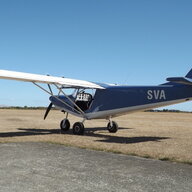To explain the gauge/sender/transducer thing further:
All of these devices have some sort of diaphragm (or similar setup) normally open to atmosphere on one side and connected to fuel/oil/whatever on the other. They work by measuring how much the diaphragm is flexed or deflected.
So, on the ground, engine off, there is equal atmospheric pressure on either side of the diaphragm, pressure reading zero.
Start the engine and there is atmospheric pressure on one side and atmospheric pressure plus fuel pump pressure on the other side. The atmospheric pressures cancel out, so you get fuel pressure.
Climb to altitude and the atmospheric pressure is reduced, but equally on both sides, so it still cancels out.
But if the atmosphere side of the diaphragm is not open to atmosphere (the shipping bung is left in the gauge) the atmospheric pressure reduces on one side of the diaphragm as the aircraft climbs, but not the other. And the result is what looks like a loss of fuel pressure.
I have seen this twice with steam gauges, and the fix is simply to pop out the rubber shipping bung on the top of the gauge body.
If this is the problem, then the setup will read okay on the ground, but the the fuel pressure reading will appear less the higher you go.
(This probably needs to be checked with the aircraft level in cruise, as a hard climb may show a reduction in fuel pressure, confusing the picture some.)
In a perfect world, the atmosphere side of the transducer would be hooked to the static port setup. But a gauge mounted in the cockpit (and so accessing cockpit atmospheric pressure) is accurate enough for practical purposes.
A sender or transducer mounted on the front of the firewall is accessing atmospheric pressure there: if mounted in a high or low pressure part of the airflow, this would also affect the reading. In this case I would expect to see the effect immediately after takeoff, rather than progressively as altitude increased.










